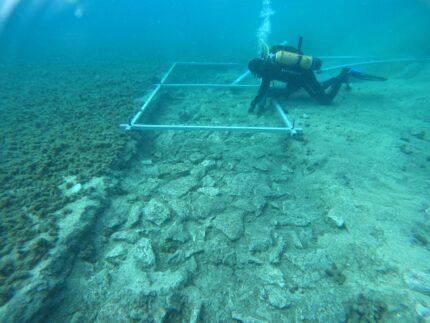 Archaeologists have discovered the remains of a Neolithic road under the Adriatic Sea off the Croatian island of Korčula. The prehistoric road connected the Hvar culture settlement at the submerged Neolithic site of Soline to the coast of Korčula. Radiocarbon analysis of preserved wood found in an earlier archaeological exploration of Soline dates the settlement to around 4900 B.C.
Archaeologists have discovered the remains of a Neolithic road under the Adriatic Sea off the Croatian island of Korčula. The prehistoric road connected the Hvar culture settlement at the submerged Neolithic site of Soline to the coast of Korčula. Radiocarbon analysis of preserved wood found in an earlier archaeological exploration of Soline dates the settlement to around 4900 B.C.
University of Zadar archaeologists were exploring sites on the coast when they saw unidentified structures 15 feet under the crystal blue waters of the Bay of Gradina on Korčula’s west coast. Under thick layers of mud on the seabed, archaeologists found a road 12 feet wide made of carefully stacked stones.
Research leader Igor Borzić noticed peculiar structures in the bay, and the archaeological team diving at the Soline site conducted a survey of the central part of the Gradina bay. To their general excitement, they discovered the presence of an almost identical settlement at a depth of four to five metres, similar to the one found in Soline, the statement highlights.
Neolithic artefacts such as flint blades, stone axes, and fragments of querns have been found at the site.
There is evidence of human settlement on Korčula going back to the Upper Paleolithic approximately 20,000 years ago. The Adriatic was more than 300 feet lower than it is today, and Central Dalmatian islands like Korčula were mountain peaks on the mainland. It became an island when the sea level rose in the Mesolithic around 10,000 years ago.
In the Neolithic period, the island was inhabited by people of the Hvar culture, as evidenced by the forms, decoration and ornamentation technique of pottery discovered there. The Hvar created Soline as an artificial island and built the newly-discovered road to link the two.